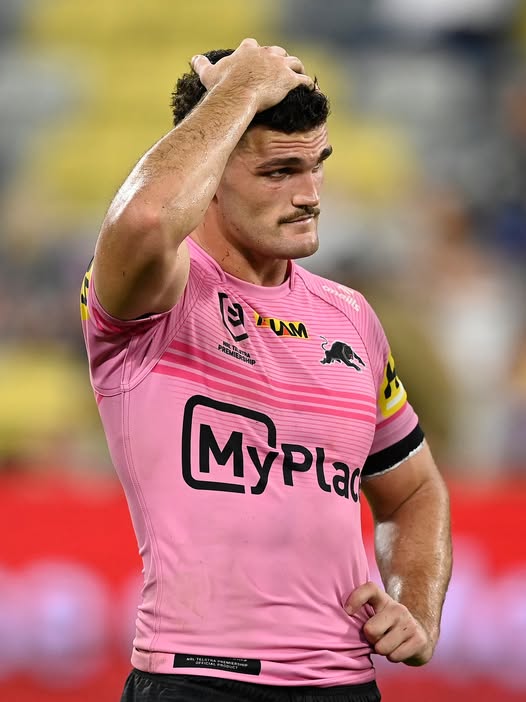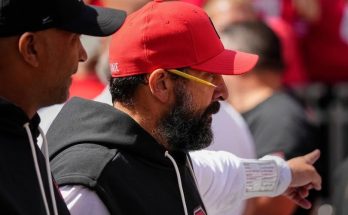The 2025 NRL season has kicked off with a thunderous wave of surprises, but none more unexpected than the strategic shifts unfolding at two of the most prominent clubs in the league: the Penrith Panthers and the Parramatta Eels. These powerhouses have thrown curveballs not only to their opponents but also to fans and pundits alike. At the heart of these developments are two of the league’s brightest stars—Nathan Cleary and Dylan Brown. Both players have been foundational pieces of their respective teams for years, and now, both are stepping into roles that challenge convention, strategy, and even their own identities as footballers.
Nathan Cleary, arguably the most dominant halfback of the past decade, is stepping into a role that diverges from his traditional duties. The Penrith Panthers, known for their robust and structured gameplay, have quietly introduced a new tactical layer to their system, positioning Cleary not just as a playmaker but as a dynamic on-field coordinator with increased freedom and less rigid structuring in set plays. This change is not a mere positional adjustment—it reflects a philosophical shift in how the Panthers intend to evolve their offense.
Meanwhile, the Parramatta Eels, who have been seeking a resurgence after a tumultuous couple of seasons, have made a bold move by altering Dylan Brown’s role within their attacking and defensive frameworks. Once seen as the more passive foil to Mitchell Moses’ flamboyance, Brown has now been thrust into a commanding hybrid role that blends aspects of five-eighth duties with a ball-running center’s responsibility. It’s a risky maneuver, but the early signs suggest it could become a masterstroke.
Nathan Cleary’s shift is significant not because he has changed positions on the field—he still lines up at number seven—but because of the latitude he is now being given to deviate from the script. For years, Penrith’s structured plays revolved around Cleary’s precise kicking, passing, and game management. He was the general, the orchestrator, always in control but often confined within the rigid framework of the game plan.
This season, however, head coach Ivan Cleary has encouraged a looser, more spontaneous version of his son. The idea is to empower Nathan to react more freely to defensive structures as they form, rather than sticking strictly to pre-planned sequences. In essence, Penrith are gambling on Cleary’s ability to read the game in real time and create opportunities on the fly—a dangerous proposition for opponents given Cleary’s IQ, but also a double-edged sword if unpredictability leads to a lack of cohesion.
In training sessions, the Panthers have been working with a modular offensive system that includes “freelance zones,” where Cleary can drift into unexpected pockets of space and assume control from different parts of the field. This allows him to interact with various supporting players—like Isaah Yeo, Jarome Luai, and Dylan Edwards—in novel ways that challenge conventional defensive formations. The underlying theory borrows from rugby union’s concept of the “second five-eighth,” where two playmakers operate with interchangeability.
What makes this particularly innovative is that Cleary is essentially becoming a roaming quarterback. Instead of anchoring himself to the ruck and directing traffic from a central position, he’s being encouraged to spread his influence across the park, often popping up in areas where the defense least expects him. This has required immense discipline and adaptability from his teammates, who must now read and react to Cleary’s movements rather than expecting him to simply initiate theirs.
The impact has been immediate. In the opening rounds of the season, Cleary’s touches per game have increased, but more importantly, so has the variety in his contributions. He’s had more line-break assists from unexpected positions, more off-the-cuff attacking kicks, and a noticeable uptick in decoy runs—something rarely associated with halfbacks. This evolution signals a shift not just in Penrith’s tactics but in how the modern halfback role can be reconceptualized.
Of course, such innovation doesn’t come without risk. The Panthers’ previous system, though occasionally labeled as rigid, was ruthlessly effective. Critics may argue that disrupting a proven formula is unwise, especially when aiming for continued premiership dominance. But the coaching staff’s rationale is clear: evolution is necessary. Other teams have been catching up, studying Penrith’s patterns with surgical precision. Introducing organized chaos via Cleary’s new role may be the perfect antidote to the predictability that elite teams inevitably develop over time.
Then there’s the human element—how is Cleary himself adapting? By all accounts, he has embraced the challenge. The maturity he has shown in the past few years is now being complemented by a growing creative confidence. Speaking to the media, Cleary stated, “I’ve always trusted the system, but I also want to trust my instincts more. This year’s about being instinctive and leading in a different way.” That mindset reflects the broader ambitions of the Panthers’ leadership, which has cultivated a culture of trust and growth rather than static perfection.
If Cleary is reinventing the halfback role at Penrith, Dylan Brown is experiencing an even more radical transformation at Parramatta. In what could be one of the boldest tactical experiments in recent memory, the Eels have begun deploying Brown in a hybrid role that sees him shift between five-eighth and center—sometimes within the same set of six tackles. This dual-role setup was initially trialed during the preseason but has now become a recurring theme in their regular season matches.
Why make such a move? On paper, Brown possesses the skill set to thrive in both positions. He’s a strong ball-runner, has deceptive strength for his size, and possesses a defensive mindset that suits edge defense. However, it’s his vision and anticipation that make this switch viable. The Eels’ coaching staff believes that by freeing Brown from the singular responsibilities of being a five-eighth, they can unleash his attacking flair in broader, more unpredictable ways.
Tactically, the Eels are leveraging a system that borrows elements from rugby sevens, where versatility and spacing are critical. When Parramatta have possession, Brown starts the set close to the ruck, often assuming playmaking responsibilities. But depending on the direction of the play and the defensive shape of the opposition, he may drift to the left edge and play as a strike runner or second receiver. Defensively, he often lines up one spot wider than a traditional five-eighth, allowing him to engage more directly with attacking centers and wingers.
The biggest surprise is how well Brown has taken to the physical demands of this dual role. The switch requires exceptional stamina, positional awareness, and mental sharpness. While some doubted whether he could juggle the mental load of switching responsibilities on the fly, Brown has proven resilient. He’s had one of his most productive starts to a season, with more tackle breaks, offloads, and try involvements than at any similar point in previous years.
Off the field, Brown’s role expansion seems to have brought him a renewed sense of purpose. Last season was turbulent—both personally and professionally—for the New Zealand international. By giving him a new challenge, the Eels may have reignited the spark that once made him one of the most talked-about young players in the NRL. When interviewed after a recent match, Brown was candid: “I’ve got a bit more space to work with, a bit more license to try things. It’s a good kind of pressure.”
From a team-building perspective, the move also benefits the Eels in multiple ways. First, it allows them to better balance their spine. With Moses firmly entrenched as the dominant kicker and organizer, Brown’s hybrid role reduces any redundancy and offers multiple attacking focal points. Second, it gives emerging players like Blaize Talagi or Daejarn Asi a chance to ease into the system without being thrown into fulltime spine responsibilities. And finally, it creates strategic headaches for opponents, who must prepare for a player who can threaten from multiple positions.
Of course, the Eels will need to monitor the sustainability of this approach. Rugby league is unforgiving, and maintaining high levels of performance while juggling dual roles can lead to fatigue and inconsistency. But the gamble so far appears to be paying off, and in a league where innovation is often the key differentiator, Parramatta’s willingness to experiment may be what helps them re-enter the top-tier conversation.
The broader implications of these moves by Penrith and Parramatta are worth considering. Both clubs are challenging entrenched norms about positional play in rugby league. Traditionally, each player has had clearly defined responsibilities, with little overlap. But the modern game—with its emphasis on speed, versatility, and unpredictability—is demanding a new kind of athlete and a new kind of system. Players like Cleary and Brown represent that evolution.
For young players coming through the ranks, these developments signal a change in what coaches may look for. Rather than pigeonholing kids into fixed positions at junior levels, there may be a growing emphasis on creating multi-dimensional players who can adapt, think, and execute in different areas of the field. That’s a massive philosophical shift, and it will impact everything from recruitment to player development to game-day strategy.
For fans, these shifts make the game more intriguing. Watching Nathan Cleary pop up on the left edge to create a numerical mismatch, or Dylan Brown busting through a defensive line as an unmarked runner from center, adds new layers of excitement to every play. These are not just minor tweaks—these are meaningful shifts in how the game is being played and interpreted.
In a league where every team is looking for a competitive edge, Penrith and Parramatta have signaled that innovation remains at the forefront of their ambitions. For the Panthers, trusting Cleary to orchestrate from wherever he sees fit is both a reward for his brilliance and a bet on his instincts. For the Eels, allowing Brown to blur positional lines is a declaration that they are ready to try something different to recapture the success that has eluded them in recent seasons.
Only time will tell how these moves pan out across the long and grueling NRL season. But one thing is clear—both Nathan Cleary and Dylan Brown are redefining what it means to be a modern rugby league playmaker. They are no longer confined by tradition. They are writing new playbooks, one instinctive run, one bold pass, one unexpected move at a time.



